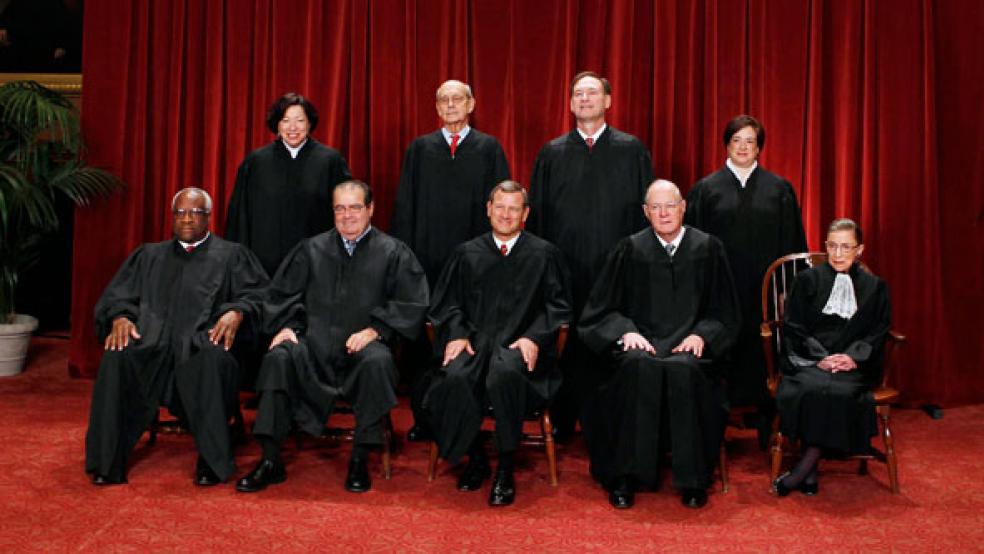Antonin Scalia died on Saturday, Feb. 13. Here's a look back on his tenure, his judicial philosophy and the legacy he leaves behind. (Monica Akhtar,Natalie Jennings/The Washington Post)
What happens now?
That's the No. 1 court-related question on Google tonight.
The short answer appears to be: Washington digs in for a fight.
As news of Scalia's death spread, Senate leaders immediately clashed over the prospect of whether to even consider filling the vacancy this late in Obama’s term.
“The American people should have a voice in the selection of their next Supreme Court Justice," Majority Leader Mitch McConnell (R-Ky.) said in a statement. "Therefore, this vacancy should not be filled until we have a new President."
Senate Minority Leader Harry M. Reid (D-Nev.) immediately rejected that position, saying "It would be unprecedented in recent history for the Supreme Court to go a year with a vacant seat. Failing to fill this vacancy would be a shameful abdication of one of the Senate's most essential Constitutional responsibilities."
[Scalia’s death plunges court, national politics into turmoil]
The combination of the timing of the opening, the stark division on the court and deeply partisan passion being evoked in both presidential primaries makes the coming confirmation battle unlike any of the past 40 years.
The last confirmation in the eighth year of a presidency was Justice Anthony Kennedy, whose 97-to-0 Senate confirmation in February 1988 came after two failed nomination efforts by President Ronald Reagan in the face of a Democratic-controlled chamber. Kennedy is now a prime villain among conservative activists, who view his rulings on abortion and gay rights with the high court’s liberal bloc as an example of GOP leaders choosing political expediency over ideological rigidity.
The only other attempt to fill a vacancy during a presidential election year came in 1968, when President Lyndon B. Johnson tried to elevate Justice Abe Fortas to chief justice. The Senate blocked Fortas and the other nomination, to fill Fortas’s spot as associate justice, was withdrawn during the final months of Johnson’s presidency.
[Republicans preparing to debate in S.C. react swiftly to Scalia’s death]
Under normal circumstances, the nomination of a justice takes about 75 to 90 days, the first 60 or so involving a thorough vetting process by the Senate Judiciary Committee. But by that point, mid-May, the so-called "Thurmond Rule" could kick in. (The rule is named after the late Sen. Strom Thurmond (R-S.C.), who during his tenure as judiciary committee chair declared that he would not take up new judicial nominations within a few months of a presidential election.)
Replacing Scalia, however, will be anything but normal. He has been the outspoken champion for the court’s conservative wing and has many admirers in the Senate.
Obama’s first two appointments to the court were relatively easy because Justices Sonia Sotomayor and Elena Kagan were replacing liberal-leaning justices.
Senate conservatives, already predisposed to not approve of Obama’s choice, might be loath to allow him to replace their judicial hero with a liberal jurist who would tip the court in a left-leaning direction.
If Republicans leave the Scalia seat vacant for any lengthy time, that sets up the possibility of a series of deadlocked four-to-four votes in which the ruling of the lower federal court would stand as the law of that particular region of the country.
The U.S. Supreme Court raised its flags to half-staff on Feb. 13 in honor of Justice Antonin Scalia, who passed away earlier that day. (Andrew Heining/The Washington Post)
While those lower-court judges are only held to a simple-majority standard, under a controversial rules change by Senate Democrats in 2013, Supreme Court nominations are still subject to a possible filibuster that would require a 60-vote threshold to advance to final vote of approval.
That political math means that Obama will need the support of all 46 members of the Democratic caucus and at least 14 Republicans to successfully appoint Scalia’s successor. In the president's previous Supreme Court nominations, just nine Republicans voted to confirm Sotomayor and four voted to confirm Kagan.
Even before Scalia’s death, the Supreme Court rulings had become a focal point in both presidential nominating contests.
Sen. Ted Cruz (R-Tex.), running as the most conservative on social issues, frequently cites the nomination of Kennedy and Roberts as huge mistakes by Reagan and former president George W. Bush, vowing to only appoint clearly conservative jurists in the mold of Scalia if he wins the presidency.
Among Democrats, Sen. Bernie Sanders (I-Vt.) cites his wish to overturn the Citizens United ruling of 2010, which allowed for independent groups to engage in political activity with unlimited donations that are often undisclosed, as one of the foundations of his candidacy.
This level of partisanship will only serve to increase the pressure on each party as they consider the nominee. Conservative activists will hold Senate Republicans’ feet to the fire and demand that they only support a proven conservative to the court.
Conversely, liberal activists will likely be upset if, in his bid to win a confirmation, Obama nominates a centrist judge in a bid to win support from the few centrist Republicans who might be willing to vote for the nominee.
This article originally appeared in The Washington Post.
Read more at The Post:





